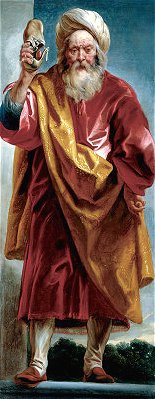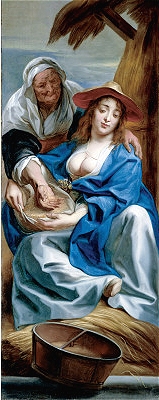 |
 |
BOAZ, RUTH AND NAOMI by Robert Anderson. 2000 |
He rarely left Antwerp, but commissions came from all over Europe, the most important
being The Triumph of Frederick Hendrik (1651-52) an enormous composition painted for the
Huis ten Bosch, the royal villa near The Hague.
During his early career he often collaborated with Rubens on the design
of official festivals and processions as well as on privately commissioned works. Rubens
remained an important source of inspiration to Jordaens throughout his life and as his
wealth increased he followed Ruben's example and built a fine home suitable for a wide
range of activities. In his old age Jordaens became a member of the
Dutch Reformed Church. He probably joined it in 1656 but the Catholic authorities had
reason to look askance at him as early as 1649.
SUBJECT
The subject is taken from the Old Testament Book of Ruth. Boaz was a
Bethlemite of great wealth. Ruth was a Moabitess, a gentile, who had married the son of
Naomi who was in turn a relative of Boaz. After Ruth's husband died there was famine in
their land and Naomi returned to Bethlehem with Ruth to seek help from Boaz, her kinsman.
At Naomi's suggestion Ruth goes into the fields of Boaz and makes sure that she is noticed
by him. He in turn is kind to her, allowing her to collect grain from his fields.
Naomi next instructs Ruth to sleep with Boaz, which she does so
successfully that shortly thereafter Boaz redeems the rights to Naomi's inheritance which
includes the right to Ruth as his wife. Boaz and Ruth subsequently married and had a son,
Obed, who was David's grandfather and an ancestor of Jesus.
PAINTING
Although Jordaens is known for his crowded tableaux, Boaz and Ruth and
Naomi demonstrate what Jordaens could achieve when he devoted his full attention to a few
monumental figures. These are exceptionally strong, well preserved pictures and are by the
artist's own hand. They can be dated to 1641/42 on the basis of style and were probably
done to decorate the artist's house, which was built at that time. The paintings would
have been hung high up between two windows or flanking a central doorway. The religious
subject would not have been out of keeping in this context, for among other decorations,
which are known to have been extensive, was a series of prophets.
Boaz is shown at the moment when he aquires the land of Naomi's husband
from her next-of-kin and, with it, Ruth as his wife. It was the custom of the day for a
man to pull off his shoe and give it to the other man as a sign whenever property was
redeemed or exchanged. In the other panel, Ruth shows Naomi the barley that Boaz has given
her after she slept with him at Naomi's behest. Boaz is shown, despite his age, as
powerful and determined. Ruth is appropriately voluptuous, yet virtuous, while Naomi is
portrayed as the wily schemer she was.
HISTORICAL CONTEXT
The story of Boaz and Ruth is traditionally interpreted as a sign that
God protects the faithful and as a beneficent act in reward of virtue. There is another
level of meaning as well : Ruth and Boaz were direct ancestors of Christ, for their son
Obed, was the grandfather of David, from whom Jesus was descended. The story of Ruth
parallels that of the Virgin, her lineal descendent, and Saint Anne, both of whom likewise
married much older men.
The fact that Ruth was a gentile has always been of great interest to
Christians in as much as Christianity is primarily a religion of gentiles.